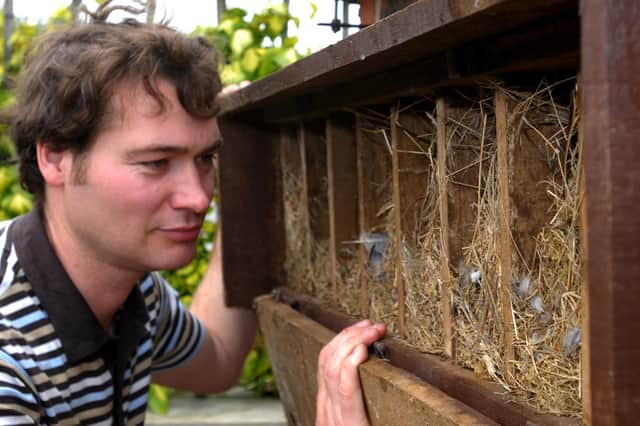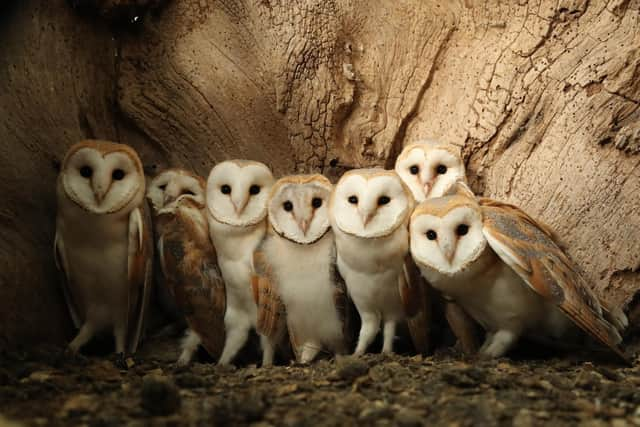North Yorkshire wildlife artist Robert E Fuller on the importance of providing nest boxes to help our declining bird population


But we can all play a part to improve things, since it’s easy to put a bird box up in your garden and offer the birds a safe place to breed.
The British Trust for Ornithology holds ‘National Nest Box Week’, running from February 14, to encourage people to put up boxes before the breeding season begins.
Advertisement
Hide AdAdvertisement
Hide AdBut in fact, you can put one up anytime, since most bird species have more than one brood and continue to look for homes throughout the breeding season.


I’ve filled my own garden in Thixendale, North Yorkshire with nest boxes, and I can always find spaces for more. And over the years I have also put up more than 200 in surrounding countryside in a bid to boost populations.
I’ve also advised local landowners on where to site boxes to attract barn owls and other species on their land. It really is important for our birdlife to try to restore the habitats these creatures have lost.
This month I’m raising funds to buy bird boxes for local schoolchildren, in the hope it’ll boost bird populations and inspire the younger generation to care for our avian friends. I’m hoping to raise £2,000 and purchase over 200 boxes!
Advertisement
Hide AdAdvertisement
Hide AdThere’s a real advantage to persuading birds to nest in your garden: it means you get to watch their young as they grow, and eventually fledge, right on your doorstep.
And watching a young chick, still fluffy with down, take to its wings for the first time is really special.
For me, having nest boxes right outside the house means I can be there to photograph, film, and paint the birds I see. Many of my art compositions feature birds I have watched right here on my doorstep.
Some of the nest boxes here are made from reclaimed tree stumps. I carefully select gnarled old elm or beech stumps to provide attractive backdrops to my paintings.
Advertisement
Hide AdAdvertisement
Hide AdThese look beautiful on the outside, but they involve some work to get them right on the inside since I also install cameras so that I can watch the chicks as they hatch and grow in their nests. I share the footage from nest cameras hidden inside on my YouTube Channel, Robert E Fuller.
For most gardens, however, a good box that appeals to the widest range of common garden birds should be around 28cm high, 15cm wide and 13cm deep with a 32mm hole. It’s important to make sure the front or top of the box opens for cleaning, which is something that you should do each winter before the new season begins.
For those that would like to attract a particular species, the box needs to be tailored appropriately. For example, blue, coal, marsh and willow tits need an entrance hole of about 25mm, which larger birds can’t get into.
Meanwhile, house sparrows are communal birds and like to nest together. They usually build their own nests, but they can be attracted to nest in man-made boxes if these are designed as a terrace of at least three boxes together.
Advertisement
Hide AdAdvertisement
Hide AdIf these are kept at around 30cm high, 38cm wide with a 32mm entrance hole, then they can imitate a natural site well enough.
House martins and swallows build their nests out of mud. House martins usually nest under the eaves of buildings, often in colonies averaging five nests. These nests are enclosed with small openings.
Swallows on the other hand prefer open nests on the inside of buildings such as a garages, porches, or stables. Like house martins, they return each year, and it is worth attracting them so that you can watch them bring up their broods year after year.
Sadly, I haven’t had swallows here for a few years now, but when they did spend their summers here, I used to water a patch of mud outside my art studio for them to use to build their nests during particularly dry weather.
Advertisement
Hide AdAdvertisement
Hide AdWhen I’m buying nest boxes, I usually choose indestructible ones made from wood-crete, a sawdust and concrete composite, because these are well insulated and don’t rot.
Most commercially available boxes are easy to put up and have been designed to attract specific bird species, but I do warn against diamond-shaped boxes which give birds less space to fill with nesting material.
I also find that boxes available online designed to attract tawny owls don’t have enough room for the owls to feed their chicks or for the fledgling owlets to flap their wings.
These boxes also tend to have the nest cavity located at the bottom of a tall box and I don’t think tawny owls can get in and out of them without landing too forcefully on their eggs or chicks.
Advertisement
Hide AdAdvertisement
Hide AdI would also warn against tube-shaped boxes designed to be strapped under a leaning branch. The openings of these are located at the top which means the owlets risk getting drenched in heavy spring showers. And if they get too wet, the bottoms of these boxes often rot.
Where you put your nest box is important. People often make the mistake of siting bird boxes where they can get a good view of the action. Unfortunately, this is the last thing most nesting birds want.
It is important to site your box out of prevailing winds and ideally out of full sun and in a sheltered spot to avoid being exposed to heavy rain.
Again, if you are trying to attract a specific species then let their natural habitat be the deciding factor when choosing where to site your box. Close to trees, for instance, if the species you want is a woodland bird.
Advertisement
Hide AdAdvertisement
Hide AdOnce your box is up then you can look forward to a fun breeding season, waiting to find out whether a bird has chosen to use it and then watching to see if any chicks fledge.
If you would like to support Robert Fuller to buy bird boxes for schoolchildren in Yorkshire, look for the donate button on his website https://www.robertefuller.com/